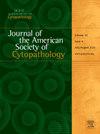心包积液细胞学:恶性肿瘤发生率、转移类型、与心包窗的比较及基因组相关性。
Q2 Medicine
Journal of the American Society of Cytopathology
Pub Date : 2025-03-01
DOI:10.1016/j.jasc.2024.12.005
引用次数: 0
摘要
心包液的细胞学评价对于诊断继发于转移性疾病的恶性心包积液和指导适当的临床处理至关重要;然而,缺乏关于恶性肿瘤发生率和原发肿瘤部位分布的大型队列和最新研究。材料和方法:对2个大型学术医疗中心近10年的心包液标本进行回顾性分析。临床和标本特征与细胞学诊断相关,并与外科病理心包标本进行比较。此外,对一部分恶性病例的基因组检测结果进行了检查。结果:共检查了1667份心包液标本,其中15.3%诊断为恶性。肺癌(50.6%)是目前最常见的引起恶性心包积液的原发肿瘤,其次是乳腺癌(13.0%)、淋巴细胞癌(12.6%)和胃肠道癌(6.1%)。在一组心包细胞学检查与手术病理检查相匹配的患者中,有84.2%的病例结果一致,而细胞学检查结果阳性但手术病理检查结果阴性的不一致病例更常见。一组恶性心包积液的基因组分析显示,最常见的突变基因是TP53、KRAS、CDKN2A/B和PIK3CA,与原发或转移部位相比,心包积液样本中高肿瘤突变负担(≥10 muts/Mb)的比例更大。结论:虽然肺癌是细胞学证实的恶性心包积液的最常见原因,但熟悉其他部位转移的相对频率可能特别有帮助,特别是在隐匿性恶性心包积液的诊断工作中。本文章由计算机程序翻译,如有差异,请以英文原文为准。
Pericardial effusion cytology: malignancy rates, patterns of metastasis, comparison with pericardial window, and genomic correlates
Introduction
Cytologic evaluation of pericardial fluid is essential for diagnosing malignant pericardial effusions secondary to metastatic disease and for guiding appropriate clinical management; however, large cohort and up-to-date studies on malignancy rates and distribution of primary tumor sites is lacking.
Materials and methods
A retrospective analysis of pericardial fluid specimens from 2 large academic medical centers over a 10-year period was conducted. Clinical and specimen characteristics were correlated with cytologic diagnoses, and compared with surgical pathology pericardial specimens when available. In addition, genomic testing results were examined in a subset of malignant cases.
Results
A total of 1667 pericardial fluid specimens were evaluated, with 15.3% diagnosed as malignant. Lung cancer (50.6%) was by far the most common primary tumor causing malignant pericardial effusions, followed by breast (13.0%), hematolymphoid (12.6%), and gastrointestinal (6.1%) cancers. A subset of patients with paired cytology and surgical pathology pericardial specimens showed concordance in 84.2% of cases, with discordant cases more frequently presenting with a positive cytology but negative surgical pathology result. Genomic analysis of a subset of malignant pericardial effusions revealed the most frequently mutated genes to be TP53, KRAS, CDKN2A/B, and PIK3CA, with a larger proportion of high tumor mutational burden (≥10 muts/Mb) in pericardial fluid samples compared to primary or metastatic sites.
Conclusions
While lung cancer is the most frequent cause of a cytology-confirmed malignant pericardial effusion, familiarity with relative frequencies of metastases from other sites can be particularly helpful, especially in the diagnostic work-up of an occult malignant pericardial effusion.
求助全文
通过发布文献求助,成功后即可免费获取论文全文。
去求助
来源期刊

Journal of the American Society of Cytopathology
Medicine-Pathology and Forensic Medicine
CiteScore
4.30
自引率
0.00%
发文量
226
审稿时长
40 days
 求助内容:
求助内容: 应助结果提醒方式:
应助结果提醒方式:


